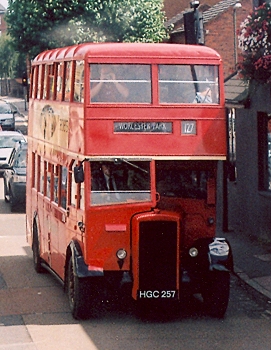
The LONDON TRANSPORT D classThis page created 5th December 1999, by Ian Smith
The Ministry of War Transport had imposed restrictions on the supply of buses during the later phases of the Second World War, controlling the designs and builders of bodies and chassis. London already had two utility chassis suppliers (Bristol and Guy) - not counting the unfrozen chassis - and did not particularly welcome a third (Daimler), when this company was instructed to start building bus chassis again in 1944. The breakthrough came when London became desperate for more lowbridge buses. It had turned down thirteen 13ft 6in Guys as too tall, the buses being redistributed to other companies (in some cases bearing Chiswick-style accessories such as bulb horns!). Now the slightly lower Daimler chassis could be accepted for use on route 127 in Wimbledon.
This Daimler lowbridge Utility is not what it seems. Quantock Motor Services own this ex-Huddersfield bus, and presented it in the guise of D130 for the Worcester Park Running Day in August 2008. It was NOT supposed to run in service wearing these number plates! It is shown here to give a good impression of the style of the Daimlers, even though the real D130 had a different style of destination display.With the lowbridge buses allocated to Merton (AL), it made sense to place the following Daimler highbridge utilities there. Another 130-odd Daimlers, with bodies by Duple and Brush, gradually took over services in the south-west of London, that became known as "Daimler-land". They came into service alongside Merton's STLs, and were fairly well received. Most had the same 8.8 litre AEC engine, and all had fluid flywheels and preselectors, so they were several shades better than the Guys in the eyes of the staff. A further fifty buses became available in 1945 just as London Transport was thinking about reinstating the Greenline services. The Romford Greenline services had used STLs before, and during, the war, and 32 Daimlers were drafted into service for the revitalised service. They soon took over the weekend services between London and Whipsnade Zoo too. A handfull of earlier buses also received the Greenline treatment when the remaining Greenline STLs were withdrawn for conversion to SRTs. The last 100 Daimlers might have had RT bodies if LT had had its way. But neither Park Royal, which won the order from LT, or Weymann (which declined), could cope with post-war metal framed bodies yet. These bodies were of wood-metal composite construction, with a hint of RT about their styling. They were equipped with a full st of display apertures, the assembly at the rear being exceedingly ugly. This batch needed another home, and they all went to Sutton garage (A), expanding Daimler-land. The Daimlers' lives with LT were short. They were swept away by the tide of standardisation as the RTs continued to arrive in the early fifties. All were sold for further service, the majority via North's of Leeds. Eighty-nine went to the South Western Omnibus Company in Ceylon, one hundred to Belfast Corporation (which rebodied them and used them until 1969-70), and other batches to variety of municipal and independent operators. For London they had been a vital stop-gap, helping them through the desperate bus shortages of the late forties, but most had longer operating lives once they had moved on. The various types are dealt with on separate pages:
AcknowledgmentsThe best source for material about the Daimlers is undoubtedly Ken Blacker's "London's Utility Buses". Another treasure-house of data is the series by John Hambley of "London Transport Buses and Coaches 19**". Specific references can be found on the photographic references page, and details of these books and others in the bibliography.
|

 Bus Stop
Bus Stop lowbridge Duples.
lowbridge Duples.